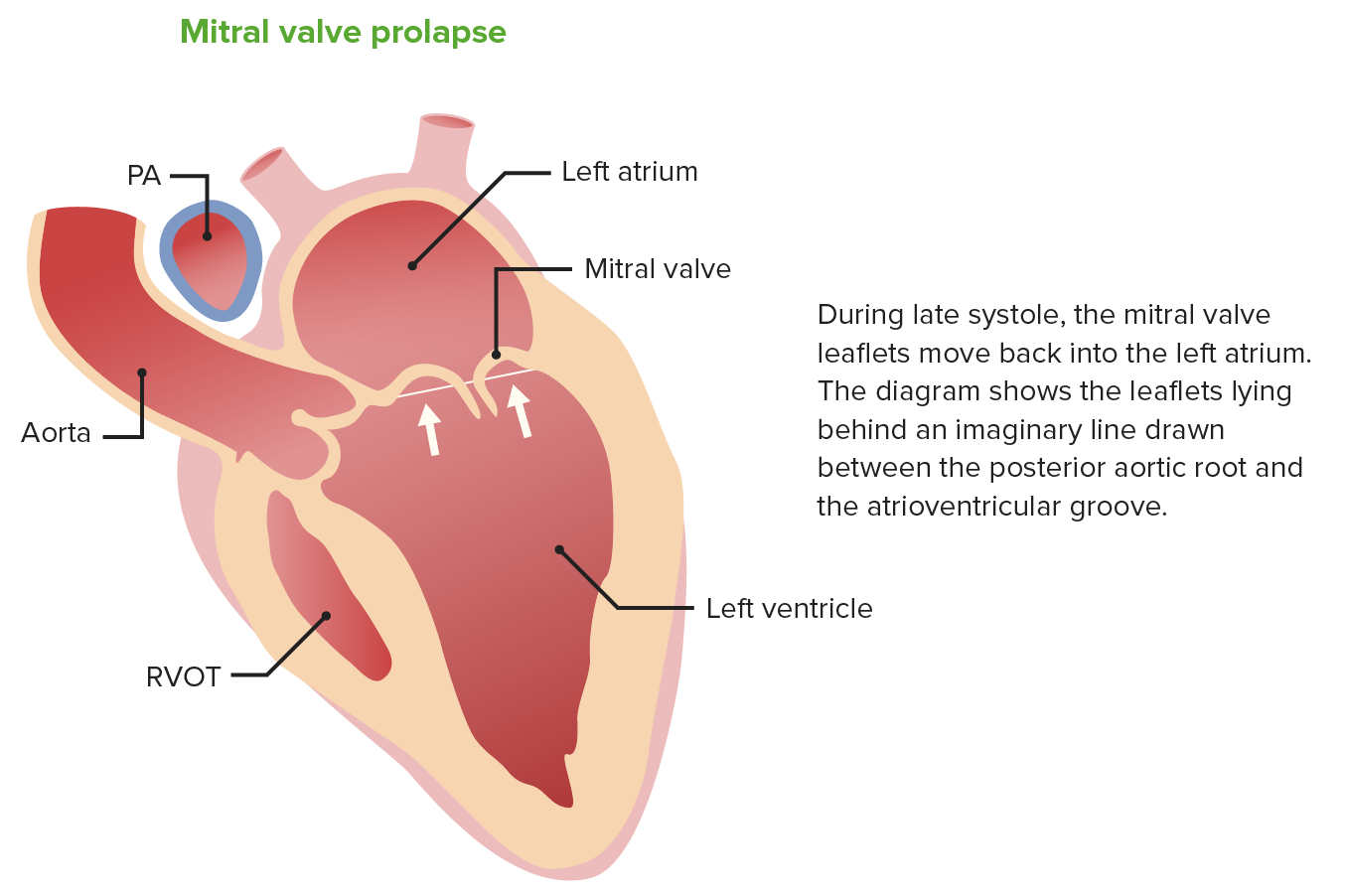Playlist
Show Playlist
Hide Playlist
Mitral Valve Prolapse: Introduction
-
Slides Valvular Heart Disease Mitral Regurgitation Cardiovascular Pathology.pdf
-
Download Lecture Overview
00:01 Now we're going to MVP. That’s what you are. 00:06 Now the most valuable regurgitation or most valuable prolapse is the following. 00:11 So what the picture on the left is showing you mitral valve prolapse but this is thickness and this is due to what’s known as myxomatous degeneration. 00:19 And the myxomatous degeneration is well, an interesting topic because really, what is MVP? Mitral valve prolapse, keep it separate from mitral regurgitation. 00:30 But Doc Raj, they're both systolic murmurs – I agree 100% but this is not going to be a wholly systolic murmur. 00:38 So wholly systolic murmur is mitral regurgitation. 00:42 Mitral valve prolapse is something called a mid-systolic click. 00:48 So what's my problem? Literally, it’s the mitral valve which is then going to prolapse and if you take a look at the echo it will exactly do this – here's my mitral valve and here's my left ventricle and here's my left atrium – it’s gonna prolapse, just like that into the left atrium. 01:04 And when it do so this left valve, or mitral valve, looks like a parachute, literally looks like a parachute. 01:11 You have the chordae tendineae, which is then trying to hang on to the mitral valve just like that. 01:16 Now hold on, and so therefore you find this mid-systolic click. It is the click, the murmur – what are you talking about Dr. Raj? Now, this is what you wanna do so that you don’t miss any questions. 01:28 You take a look at mitral valve prolapse and you divide it and dissect it into four different components and then you apply certain maneuvers and when you do so, it will all come together. 01:40 Four different components, yes. Two are normal and two are pathologic. 01:44 The two that are normal were S1 and S2, clear? Right off the back, S1, S2 – I snuck that out. 01:51 Next, it’s a systolic murmur – what does that mean? You're having issues with closing, right? And the only way that you could have a mitral valve disease and it being systolic it’s a problem with closing. 02:03 So it could either be mitral regurge or in this case, it would be mid-systolic click. 02:08 My point is, all murmurs between S1 and S2 are systolic. 02:13 This is a click at the third component. 02:16 So you have S1, S2, in the middle we have a click somewhere at the third component. 02:22 Then we have the murmur. The click is not the murmur, no. Why is that important? Because in pharmacology the management of MVP, you do everything in your power and our power to reduce the amount of murmur. 02:41 You want that or murmur to be reduced for management and to tell you right off the back, the number one recommendation that you'll be doing to a young lady that has mitral valve prolapse, exercise. 02:54 Really, cuz when you exercise what happens to venoconstriction? Actually, I just caved the way, so you do have venoconstriction with exercise. 03:04 Venoconstriction, you have to. How else can you have increase preload? You do. 03:09 How do you have increase cardiac output? Venoconstriction. 03:12 When you do so you have increase venous return. 03:15 You, as a doctor seeing a young lady with mitral valve prolapse you recommend exercise. 03:22 When you recommend exercise what are you doing to that murtmur? What did I tell you that you wanna do? What is your objective to create for MVP to reduce the amount murmur after that click, and by increasing the preload in your heart the murmur after the click is going to be reduced. 03:41 Voila! You have helped your patient probably forever more, it’s amazing. 03:45 If that doesn’t work, I'll go take you to the next step in management. 03:48 Let’s continue. 03:50 So here we go. Seven percent in the population – that’s quite high, MVP, keep it separate from mitral regurge I beg of you. Myxomatous degeneration, I showed you a picture previously with myxomatous degeneration. 04:02 We have thickening of the mitral valve. 04:05 Primary disorder it could occur genetically. 04:08 Associated with connective tissue disease such as Marfan, once again Ehlos Danlos. 04:16 Mostly benign asymptomatic but worst case scenario, you're thinking about syncope issues and chest pain especially with anxiety. 04:24 MVP, a mid-systolic click. Hey doc, I feel like my heart is palpating. 04:30 Hey, doc, I feel like my heart is going to jump out of my chest. 04:34 You know, there are some things that your patients are going to then express to you.
About the Lecture
The lecture Mitral Valve Prolapse: Introduction by Carlo Raj, MD is from the course Valvular Heart Disease: Basic Principles with Carlo Raj.
Included Quiz Questions
Which of the following represents the pathology in mitral valve prolapse?
- Myxomatous degeneration
- Dystrophic calcification
- Senile calcification
- Bicuspid valve
- Rheumatic heart disease
Which of the following is heard with mitral valve prolapse?
- Mid-systolic click with or without a murmur
- Diastolic murmur
- Early systolic murmur
- Murmur of mitral stenosis
- Systolic murmur with an S3
Which of the following conditions is most commonly associated with mitral valve prolapse?
- Connective tissue disorders
- Rheumatic heart disease
- Endocarditis
- Myocarditis
- Ankylosing spondylitis
Customer reviews
5,0 of 5 stars
| 5 Stars |
|
1 |
| 4 Stars |
|
0 |
| 3 Stars |
|
0 |
| 2 Stars |
|
0 |
| 1 Star |
|
0 |
excellent review! I finally understood. All these concepts are difficult for FNP students. I think Dr. Raj made it easy to understand, to follow and it was humorous. Thank you




